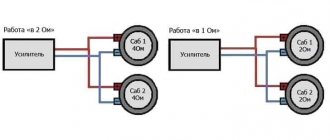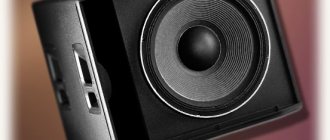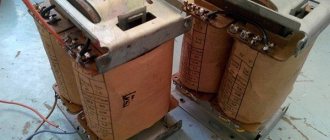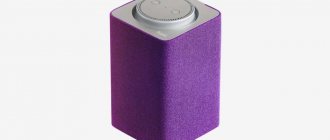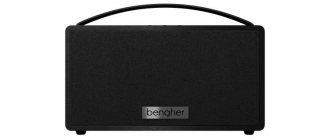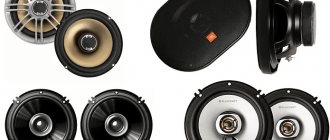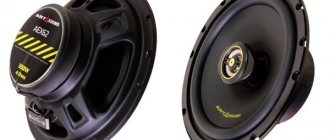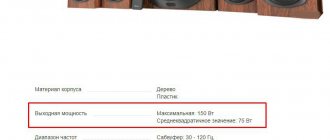Everyone has already become accustomed to the loud thousands of watts that the manufacturers of Chinese boomboxes promise us. Well, let their love for zeros remain with them, and today we will find out what power of speakers and amplifiers is really needed and how many watts are enough to provide sound in your home...
The choice of listening volume is determined both by the preferences of the music lover himself and the tastes of his neighbors. But if we approach the problem posed more scientifically, then the neighbors should be told that the answer will not be in their favor. Especially if their musical preferences do not match yours
The range of intensities perceived by the ear from the hearing threshold to the pain threshold is 140 dB. This is a huge interval. Of course, no one in their right mind would listen to music at volumes close to one of the thresholds, and the power of the speakers and amplifier should not be small, but in order to hear certain components of the sound it is necessary that they have a sufficient level of intensity.
Research results
Many studies have been conducted to determine the preferred sound volume level for listeners of different social composition, age and gender when playing musical works of various genres and performers in normal-sized residential premises. Some generalized results are presented in the table (figures are given in dB):
It is clear that these indicators are influenced by many factors that can confuse and modify the statistics. The noteworthy thing here is that people who play music professionally require higher volume levels. I don’t know if this is related to the requirements of the profession or whether it is an occupational disease.
If you are familiar with musical terminology, then it is worth saying that in order to obtain the desired dynamics of the orchestra, it is necessary to create a sound level of 80 dB on forte (f), on fortissimo (ff) - 90 dB and on forte fortissimo (fff) - 100 dB. Below 80dB the dynamics are not sufficient, and above 100dB it will be insane... These high sound pressure levels are only valid at moments of peak power.
According to averaged experimental data, acoustic levels at different dynamics of musical performance correspond to the values indicated in the table.
Choice
For example, the OK supermarket uses up to a hundred speakers with a power of 5 W each - one building occupies more than a hectare of territory. Such systems are driven by one high-power mono amplifier. Or each column is made active.
The best material for a speaker is natural wood. Lumber based on it - for example, varnished and painted chipboard - is a cheap substitute for oak or acacia, but the lion's share of the cost of the product is still not concentrated in the board. The value of the type of wood does not matter - a wooden or lumber slab must be sufficiently rigid.
If you come across a speaker with a chipboard body, on which the manufacturer clearly saved money on processing, then it is additionally impregnated with a waterproof adhesive-based varnish (you can use parquet) and painted over with several layers of decorative paint.
To avoid this, choose speakers with a body made of natural wood - it requires less maintenance.
The acoustics should be easily portable - it’s better to go a few extra times than to strain yourself when carrying such speakers from the van to the podium and back. Concert speakers (at least 2) must be of extremely high quality sound, easy to place and connect.
Don't buy a multi-channel system - for example, for a school auditorium - if you don't need it.
Loading. Please, wait.
why not? Otherwise, people often continue to buy “kilowatts”, and then wonder why it’s so quiet. And the difference in sensitivity of only 3 dB means that you need to buy twice as many speakers and amplifiers.
By the way, am I the only one who thinks that to work with the same rock band there is generally a certain minimum for holding an event? Or do you want to say that at a closed party for five and a half people (5.5 * 50V) = 275 W one speaker from Volta?opcorm2 will be enough for you:
This all illustrates very well the uselessness of the concept of “power”. I would generally prohibit the use of it when building PA systems)) At the same time, it is simple and clear when it is said that it is required to provide such and such sound pressure in the hall.
What kind of lighting do you prefer?
Built-in Chandelier
Expert opinion
It-Technology, Electrical power and electronics specialist
Ask questions to the “Specialist for modernization of energy generation systems”
BEST SOUNDBAR - TOP 9 rating of sound panels Advice: if you painted the walls in dark colors with a matte tint and selected furniture of the same color, then the number of light sources should be calculated with a small margin. Ask, I'm in touch!
Power of musical instruments
Have you ever wondered how much power musical instruments produce? The following table provides data on the acoustic powers emitted by various musical instruments. Please note that this is acoustic power, not electrical power. A piano, for example, creates 0.4 W of acoustic power, which is 8 W of electrical power, with an efficiency of 5%.
It follows from the table that the largest acoustic power ratio (between a triangle and a large orchestra) is over 1000. A large number, but in fact it is not particularly much for our ears. An orchestra of 75 players is only 8 times more powerful on the ear than a triangle.
Choosing acoustics for a small event in 2022
ex Drap
why not? Otherwise, people often continue to buy “kilowatts”, and then wonder why it’s so quiet. And the difference in sensitivity of only 3 dB means that you need to buy twice as many speakers and amplifiers.
yeah, and only legalize 10W amplifiers. everything else should be ritually burned at the stake.:holiday: Power and sensitivity are equally abstract concepts in this situation.
This all illustrates very well the uselessness of the concept of “power”. I would generally prohibit the use of it when building PA systems)) At the same time, it is simple and clear when it is said that it is required to provide such and such sound pressure in the hall.
I would like to look at the eyes of the customer who was asked “What sound pressure would you like?” I wonder if customers often turn to Subbotin with a request to push the mix to 9.6 dB RMS or do they just say “louder”?
For example: there is 280 m3 of air volume in the room, it is necessary to ensure 96 db spl listening pressure level at the farthest point (12 m from the speaker). How to calculate?
at a distance of 12m the attenuation is 21.5 dB. 96+21.5=117.5 dB/m should be at the output. But this will only be on the sine wave of the generator signal. In fact (with live action) the dB will be 6-10 quieter.
Choosing acoustics for a small event in 2022. A set of acoustic systems (speakers) for wedding ceremonies, presentations, seminars, receptions, openings of shops and boutiques, parties with a small number of guests up to 100 people. A number of available kits that are worth purchasing.
To choose the right speaker system to use at your event, you must consider the size and type of room, as well as the number of people who will be there. Small spaces require a smaller, less powerful sound system than outdoor spaces where there is nothing to bounce sound.
Additionally, large crowds tend to "soak up" the sound, so more crowded situations will require a speaker system that can produce more volume.
In this selection, we will look at installations with two active speakers, which are more likely to help “sound out” wedding ceremonies, presentations, seminars, receptions, openings of stores and boutiques, parties with a small number of guests up to 100 people.
Some popular speaker systems also have additional features, such as the ability to stream music via Bluetooth, a dedicated USB port for connecting flash drives with music, and much more.
Our recommendations for active speaker systems, all options are indicated taking into account the use of 2 speakers (total power of at least 1 kW and bass of at least 12 inches):
HH Electronic VRE-12AG2 - power of a set of two systems - 1.6 kW. 12″ woofers. Sound pressure level 96 dB. Built-in 3-channel mixer, equalizer, Bluetooth, USB, SD memory cards, direct microphone connection, built-in glass for installation on a stand, convenient carrying handles.
The VRE-AG2 series from HH are quite good acoustics for a very small budget. The kit will provide any speech and music applications.
HH Electronic VRE-15AG2 - power of a set of two systems - 1.6 kW. 15″ woofers. Sound pressure level 97 dB. Built-in 3-channel mixer, equalizer, Bluetooth, USB, SD memory cards, direct microphone connection, built-in glass for installation on a stand, convenient carrying handles.
The VRE-AG2 series from HH are quite good acoustics for a very small budget. The kit will provide any speech and music applications.
Concert speakers: choosing professional acoustics for home and hall. Power and other characteristics
read as “jazz'ny” :holiday: This is everything that in a club does not require powerful sound, for example, jazz music concerts, all kinds of bard song festivals, evenings of poets of the seventies, etc. and so on. .
Expert opinion
It-Technology, Electrical power and electronics specialist
Ask questions to the “Specialist for modernization of energy generation systems”
Calculation of the power of speaker systems | Then take 5 W per person for your calculation, or simply adjust the volume of the amps on stage and go drink green tea. Ask, I'm in touch!
Calculation of recommended power
There is a simple formula by which you can easily calculate the minimum recommended electrical power (W) for a room with volume V (m3) at a selected sound level I(dB) and reverberation time in the room tr(c)
η - loudspeaker efficiency in %.
Because We all live in approximately the same size rooms, so for calculations we will take the average values. Let's take the volume of the room to be 50 m3, we will listen to the symphony orchestra in all its glory, so the sound level I = 100 dB (maximum), and let's take the speaker efficiency to be 5% (average value, by modern standards). In this case, we get Pel=3.2/tr
For a living space of similar volume, the reverberation time is 0.75 s. Accordingly, the required minimum electrical power of your sound path should be 4.2 W (in the case of stereo, 2.1 watts per channel).
However, everyone knows that companies producing both high-quality and mass-produced amplifiers, and indeed any amplifiers, advertise them with higher powers - 50, 100 and even 200 watts. Of course, this power remains underutilized in room conditions, but allows for wider playback dynamics and a lower level of signal distortion.
Principle of operation
The most commonly used are two- and three-way speakers. For cinemas, where multi-channel and surround sound is critical, several bands are also used. The simplest stereo system is two speakers, in which all three bands are transmitted in each of them. It's called 2.0. The first number is the number of speakers, the second is the number of subwoofers.
The main range of concert speakers is represented by the following manufacturers:
- Alto;
- Behringer;
- Biema;
- Bose;
- Current Audio;
- dB Technologies;
- Dynacord;
- Electro-Voice;
- ES Acoustic;
- Eurosound;
- Fender Pro;
- FBT;
- Focal Chorus;
- Genelec;
- HK Audio;
- Invotone;
- JBL;
- KME;
- Leem;
- Mackie;
- Nordfolk;
- Peavey;
- Phonic;
- QSC;
- RCF;
- Show;
- Soundking;
- Superlux;
- Topp Pro;
- Turbosound;
- Volta;
- X-Line;
- Yamaha;
- "Russia" (a domestic brand that assembles acoustics for trading floors mainly from Chinese parts and components) and a number of others.
Some manufacturers, focusing exclusively on legal entities and wealthy clients, produce 4-5 channel acoustics. This inflates the price of the package (speakers, amplifier and power adapter).
Expert opinion
It-Technology, Electrical power and electronics specialist
Ask questions to the “Specialist for modernization of energy generation systems”
15 best subwoofers for the home - rating 2022 The first step to the correct calculation is familiarization with generally accepted standards for room lighting with a ceiling height of no more than three meters, which in general boil down to the following indicators. Ask, I'm in touch!
Selecting acoustics
When choosing acoustics, you should pay attention to important factors:
Acoustic device type
This characteristic is the main distinguishing feature of acoustic devices, if the choice is made professionally. For an ordinary person, the sound from a closed-type device will not be distinguishable from bandpass acoustics. But for those who went to music schools or are lovers of high-quality sound, information about five types of acoustic design will be useful:
- Open type speakers (belong to a subtype of horn devices). When properly positioned in a room, they can form a primitive-type acoustic system that immerses you in the atmosphere of music or cinema. But such devices lack bass quality.
- Bass reflexes. Devices of this type have many discrepancies and most systems on the market are considered bass reflexes. According to professionals, such a device has good bass quality, but it has problems with sound detail.
- Passive radiators are similar to the previous type of device, but they have better bass quality.
- Closed-type systems have a more precise sound, which is weak in power, and their bass quality also suffers.
- Bandpass systems or bandpass will appeal to lovers of loud sound, as such devices have the most powerful sound.
Number of lanes
Taking a simple approach to this issue, it can be argued that a device with a large number of bands has deep and spacious sound, but is more expensive. Speaker systems for home use have 1-3.5 bands.
Sensitivity and power
If you want music or a movie to be heard by neighbors on the floor above and below, then you need to choose a powerful system that will also have good sensitivity, no matter how it is measured, in W or dB.
When there is no desire to purchase a powerful device, you can opt for systems with an amplifier, which can be built-in or purchased separately as an external device.
Frequency ranges
This parameter is quite popular among device users, but the sound quality practically does not depend on it. There is one simple rule that puts everything in place: floor-standing speaker systems cannot sound at a frequency below 35-40 Hz; only subwoofers are capable of this. When a frequency range of 20-20,000 Hz is indicated when selecting a device, it is a subwoofer, or the information is not true.
Theoretically, there may be another outcome - an expensive acoustic system designed for use by professionals could have this characteristic. But there are few of them on sale.
